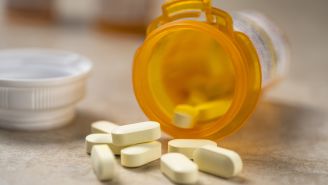Updated on May 31, 2024.
Since 2011, the number one cause of unintentional deaths in the United States hasn’t been falls, drownings, or even car accidents. It’s been accidental poisonings, most of which are drug overdoses.
While overdoses have been a serious public health issue for some time, the problem worsened significantly during the COVID-19 pandemic. There were nearly 92,000 drug overdose deaths in 2020, an increase of 31 percent from 2019, according to the Centers for Disease Control and Prevention (CDC). In 2021, that number rose again to almost 107,000.
Of these overdose deaths, about 75 percent involved opioids, a class of drugs used to reduce pain. Fentanyl, a synthetic (lab-made) opioid 50 times more potent than heroin, played the largest role.
Illegally produced synthetic opioids like fentanyl are now the primary drivers of the drug epidemic. It’s a key difference from previous decades, when prescribed opioids were a much bigger issue. Learning how and why this changed—and what it is about opioids that creates dependency—is key to understanding addiction in the U.S.
Understanding opioid overdose trends
In the 1990s and 2000s, opioid overdose deaths were driven largely by prescription drugs. They were often prescribed by healthcare providers (HCPs) to help people manage chronic pain, such as that stemming from a back injury or medical condition. Many areas across the U.S. were flooded with these highly addictive painkillers, which led to widespread misuse and addiction.
By the early 2010s, overdose deaths involving heroin started to rise. For some people who were already misusing prescription opioids, heroin was a stronger, cheaper, and more widely available alternative.
In 2013 and 2014, synthetic opioids started to take over. Overdose deaths—primarily involving fentanyl—skyrocketed, and have continued to climb ever since. Price and accessibility have been factors, as well as the following.
- It can be easier to overdose on synthetic opioids, as many are far more powerful than other drugs users are accustomed to.
- Many people take synthetic opioids in combination with cocaine, methamphetamine, and other drugs, which increases the likelihood of overdose.
- Synthetic opioids—especially fentanyl—are frequently laced into other drugs without users knowing, raising overdose risk.
There were fewer than 20,000 U.S. drug overdose deaths in 2001. Twenty years later—in 2021—there were more than five times that amount. The rise of synthetic opioids goes a long way towards explaining that spike.
Opioid overdose—what to look for
If your body cannot handle the amount of a drug you take, you could have an overdose. This can lead to serious health problems or death. Signs of overdose include:
- Pale or clammy skin
- Limp body
- Purple or blue fingernails or lips
- Vomiting
- Not being able to speak
- Not waking up from being asleep
- Breathing or heartbeat that slows or stops
Call 911 right away if you see a person with any of these signs.
Why opioids are so addictive—and deadly
“There may be some genetic predisposition,” says says Mark Cardillo, LCSW, program director for behavioral health and addictions at Tampa Community Hospital in Tampa, Florida. “You also have a segment that may turn to drugs and alcohol because they have some issue, like trauma or their upbringing. In order to escape, they turn to drugs. Another group has some sort of mental health disorder and uses drugs to deal with that. Usually there’s some component in their lives that pushes them to addiction.”
Snorting, swallowing, or shooting opioids not only dulls the sensation of pain, but also causes a feeling of intense euphoria. At the same time, these drugs affect parts of the brain that influence a number of body functions beyond pain sensation and pleasure, including the breathing instinct. If you take too many opioids, you may stop breathing.
Your body naturally produces opioids, but when you flood it with opioids from an outside source, it adapts to having that influx. Then, when you stop putting outside opioids into your body, the body’s natural levels of opioids are no longer enough, and you go through withdrawal. This process is known as dependence.
Withdrawal symptoms include agitation, anxiety, muscle aches, insomnia, diarrhea, nausea, and vomiting, among others. Many people, even with the best of intentions, will go back to using opioids once they experience withdrawal symptoms.
Getting clean and staying clean
According to Cardillo, the first stage of recovery is detox, which involves a difficult withdrawal process. “You just have to get the drug out of your system, so you can think clearly,” he says. Detox takes between five and seven days, says Cardillo, but it could take up to a month before you start feeling more physically well.
“Once you tackle that, you work on the psychological part,” Cardillo says. Treatment is vital to dealing with an opioid addiction, and behavioral therapy is widely acknowledged to be an effective approach—especially when it’s combined with prescription medications. Treatment may also involve altering aspects of a person’s environment that may trigger their drug use.
In fact, Cardillo says that the biggest mistake people recovering from an opioid addiction make is “not changing the people, places and things that will put them in situations where they’re going to use again.”
Not embracing therapy is another stumbling block. “Therapy can be painful, so the first instinct is to go back to using,” he says. “The reality is that drugs and alcohol work. You take them and you don’t have to think about your trauma.”
"You have to be extremely diligent to maintain sobriety,” adds Cardillo. “Most people say you go ‘into recovery,’ not necessarily that you’re cured. People may have been in recovery for 30 years, but they’re not cured. Any day something could trigger them and make them start using again. They have to take it one day at a time.”
Where to start seeking help
If you or a loved one are misusing or addicted to opioids, get help as soon as you can. Support groups and counseling can be key to recovery. Organizations such as the Substance Abuse and Mental Health Services Administration (SAMSHA) national helpline (1-800-662-4357), Mental Health America, and Narcotics Anonymous can provide information and support for managing withdrawal and preventing relapse. Your HCP is also a valuable resource. The sooner you reach out, the sooner you can start the journey.







